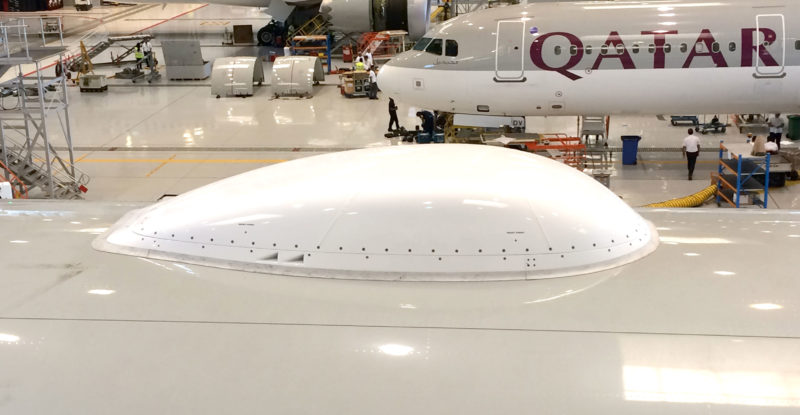With Inmarsat Global Xpress Ka-band connectivity kit delivered factory-fit on Qatar Airways’ latest Airbus A350s, and the rest of the carrier’s A350s in line for retrofits, Inmarsat’s confirmation this week that it has directly obtained a supplemental type certificate (STC) to install on Qatar’s Boeing 777s might seem par for the course. But the achievement is not only significant for the London-headquartered satellite operator – which is increasingly going “direct” in providing cabin connectivity to airlines – it will also drive out costs and create efficiencies for carriers, according Inmarsat.
“What of course we’re trying to do is bring a bit more efficiency to these STCs. There are a lot of people that would like to see the full price charged each time even though there will be a lot of engineering work done [with the first STC]. For us, certification and STC work is not really a profit center; it’s something we do to facilitate introduction of our service,” Inmarsat Aviation president Leo Mondale tells Runway Girl Network.
“The reality is that you need to do some custom work with every variation of aircraft type and frankly if you switch it around with MROs and STC support people you don’t get the benefits of doing the work on a similar aircraft type. We try to bring some efficiency to that which helps us in terms of cost and schedule. We are looking for efficiencies and avoidance of redundancy and to make it as quick and economical as possible.”
In past years, Thales led the messaging around GX for Qatar Airways’ A350s. But while Thales and other Inmarsat partners are supporting the rollout of GX at the airline – Thales, for example, “is the linefit supplier of GX on the A350” – Inmarsat is now “prime” on the contract with the airline, says Mondale. That means working with the airline closely to make sure that the connectivity rollout “fits with the hardware and other services they’ve contracted with, like the IFE and cabin networks so you’ll see us mixing and matching in a lot of cases. Qatar Airways doesn’t have a five-star reputation for nothing. They want accountability for the service so we have provided that … Thales, Honeywell, EAD Aerospace are all partners that we work with closely, but ultimately they are supporting us in delivering the [service].”
https://twitter.com/EADAerospace/status/903589399807578114
Inmarsat’s specific arrangement with Qatar Airways covers connectivity on board more than 130 of the airline’s aircraft, including all A350s and 777s. Notably, Qatar Airways chief Akbar Al Baker previously publicly suggested that the 777s would be fitted with Panasonic Ku, but later changed course.
Under the deal with Inmarsat, Qatar Airways “settled a number of parts of the connectivity strategy for the A350 that weren’t resolved” and confirmed inclusion of the 777s, according to Mondale. “For us, yes there was a probability that they’d want to go with this, but to get it all resolved – they’ve gone through a number of competitive processes, including reviewing bids from competitors [discussed in 2015 on RGN Premium], etc – they hadn’t made a decision on A350 that drove their overall fleet strategy. We’ve worked on this for a long time and we did try to move away from the claim game, and talk about building a network that serves their configuration, around their peak hub in Doha and ultimately I think [that] is what persuaded them so science won.
“The things that got us over the line with Qatar [are] we’ve engineered for performance and worked with quality of service that makes it consistent for them to manage as a product. Something that is fast today, slow tomorrow, and available only 85% of the time – that is not going to cut it as a product in this next generation of connectivity space, and Qatar doesn’t plan to go through that learning curve of the last seven or eight years. They’re planning to step straight to a highly reliable system that will be manageable.”
https://twitter.com/SimonHeinz3/status/851144673724968962
In terms of actually doing the install work, Qatar Airways is a “capable MRO in their own right, and they’ll be taking care of that”, says Mondale. And the rollout of GX for passengers is “nicely aligned with their QSuite [business class] and some other innovations [and digital strategy] so it will be part of a pretty impactful rollout in business class in this region”.
The airline will decide when to activate the service for passengers, of course. It is “expected they will have trials and test marketing and trying out the product and configs” but the service on the fleet “will start to receive critical mass towards the end of this year”.
But beyond the Qatar 777 STC, which will be applicable to other carriers’ 777s, Inmarsat will be “obtaining STC and linefit” for other types, says the Inmarsat executive. “What we’ve been investing to do – and progressing consistently – is to be both retrofit and linefit approved and offerable on every major aircraft type from Boeing and Airbus but also the other providers.”
GX is already offerable on Airbus aircraft via integrators Thales, Zodiac Inflight Innovations and Rockwell Collins, as part of the airframer’s High Bandwidth Connectivity program. But Inmarsat is “in the process of becoming offerable on all of Boeing’s aircraft types, except the ones they’re retiring like the 767”, divulges Mondale, adding that “we’re largely able to satisfy airlines’ needs in terms of getting their new aircraft delivered with GX”.
Related Articles:
- Qatar pursues multiple flight tracking paths; will one reign supreme?
- Qatar faces user experience decisions as A350s get fitted with GX
- RGN Premium: Oh-Ka
- Qatar Airways makes split inflight Internet decision in face of delay
- Press Release: Inmarsat certified for GX installs on Qatar 777 fleet
- Press Release: Qatar Airways confirms intention to adopt GX connectivity











